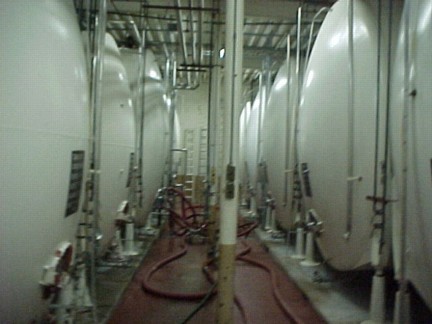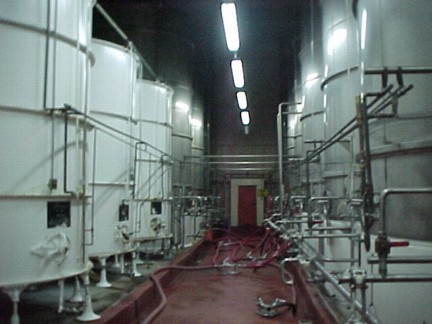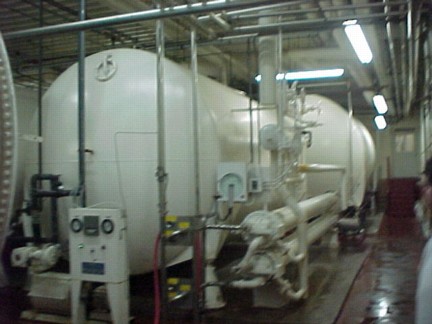After fermentation, the newly formed beer is far from perfect in many respects. The taste may be harsh, the odour pungent, estery, or yeasty, and physically the product is not yet stable. We find people with many erroneous ideas concerning the length of time beer is aged. Length of aging is dependent on alcoholic content, so that wines, whiskies and liqueurs, being higher in alcoholic content, require greater periods of time to mature.

Above: Primary Storage
Below: Secondary Storage

During the aging (or cellaring) process, very slow changes occur. Carbon dioxide gas is slowly evolved until there is only a very low oxygen content. Yeast cells which are carried down from the fermenter to the primary tanks slowly settle out of the beer and it becomes clarified to an extent. In addition, the colloidal constituents of the beer are slowly changing and we have a further coagulation and precipitation of proteins. Accompanying these changes, the flavour of the beer is improving because of ester formation.
After aging in primary storage, the beer is transferred to the secondary storage cellar. During transfer, the beer passes through the filter room where it is carbonated. We increase the carbon dioxide content to further ensure reduction of the oxygen content. This process is facilitated using a pinpoint carbonator, or stone, through which the gas is injected under pressure. An alternative method is to inject the gas into the beer stream at a suitable point during the pumping operation, usually on the discharge side of the centrifugal pump used to move the beer from the primary tank to the secondary storage tank.

Above: Bright Beer Tanks
Below: Filter Room

The temperature of the beer is also lowered to approximately -2 to 0°C (28-32°F). This process is accomplished via large shell and tube coolers. The beer flows through a pipe which is encased by a larger shell containing ammonia. Is this way, very exact temperatures are attained.
The third operation during the transfer is filtration. We remove yeast cells and precipitated proteinaceous materials by means of filtration through diatomaceous earth which acts as the filter aid. The filtered beer then passes from the filter to the secondary storage tank located in the secondary storage cellars. Here the temperature is maintained at 0°C (32°F).
The beer is further conditioned during its stay in the secondary storage cellar. The low temperatures "chillproof" the product, since the beer contains proteins in solution which will precipitate when subjected to very cold temperatures. We must condition the beer to these temperature changes, remembering that the product may subjected to many temperature variations when it reaches the consumer. Therefore, the reason for the secondary temperature is obvious. By subjecting the beer to a relatively low temperature, we cause any "borderline" proteins to precipitate; thus increasing the physical stability of the product once it is in the bottle. This increases its shelf life and decreases the possibility of a protein haze formation.
After secondary storage, the beer is again returned to the filter room where it receives its final processing before it is placed in the bottle, can or keg. The beer receives a final carbonation using the same type of injection system as mentioned earlier. Generally, beer processed for the bottle or can is carbonated to a higher degree than beer being processed for the keg because of the foaming problem encountered when filling a keg, and because the public prefers a lower carbon dioxide level in draught beer. The actual carbonating operation is an art with very exact results required. Over-carbonation will result in foaming when the bottles are opened and will cause difficulties at the filling machines. Under-carbonation will produce a poor foam layer or "head" on the beer when the bottle or can is poured, or a glass is drawn from a keg.

Above: CO2 collector on left, Beer cooler on right
The carbonated beer is then again passed through the shell and tube cooler to bring the temperature to exactly 0°C (32°F). It continues through the filters where the proteins precipitated during the finishing, or chillproofing, process are removed. From the filters, it passes to the tanks in the bottling tank cellar.
The beer rests in the bottling tanks under a counter pressure of carbon dioxide. Every precaution is taken to minimise the oxygen content of the product, from the time the beer leaves the fermenter through all the storage and pumping operations until the beer is packaged.
The oxygen tolerance for the final product is very low. Excessive amounts cause slow protein oxidation, producing unpalatable flavours and decreasing the product's shelf life. Therefore, we are constantly endeavouring to prevent product contact with air.